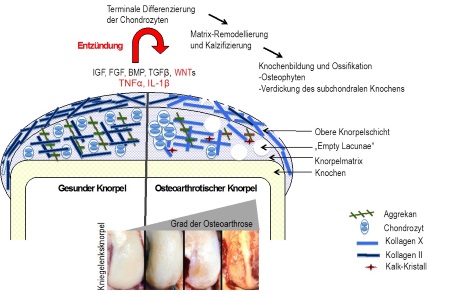Signaling Cascades in the Maintenance of Cartilage Homeostasis.
Osteoarthritis (OA) is the most common degenerative joint disease, leading to chronic progressive destruction of the articular cartilage and the formation of osteophytes at the edge of the affected joints. The affected joints become stiff and immobile, and patients suffer chronic, increasingly severe pain. Until now, the use of artificial joints has been considered the only method to restore patients' mobility. The mechanisms that lead to the development of osteoarthritis are not yet fully known. What is known is that the cause is a very complex pathophysiological process and a number of factors underlie it. In addition to mechanical factors such as obesity, overuse, and trauma-induced instability and loading errors, genetic factors also appear to contribute to the development of osteoarthritis. These findings suggest that "osteoarthritis" is a reaction of cartilage tissue to very different patterns of damage, but may have different etiologies. Accordingly, the common factor is irreversible cartilage loss.

Healthy articular cartilage consists of two zones (see figure) that differ in their molecular structure. In the upper layer of cartilage, there is a dense network of predominantly collagen II fibers in proportion. In the underlying cartilage, the chondrocytes are embedded in a looser network of collagen II and other collagens, but also various proteoglycans, mainly aggrecan. Chondrocytes are in a postmitotic resting state in adult cartilage. They are responsible for maintaining the homeostasis of the cartilage so that anabolic and catabolic processes are in balance.
During OA, complex changes in this homeostasis occur for reasons that are only partially understood. Chondrocytes become hypertrophic and cluster together. Later on, there is an increase in apoptosis of chondrocytes, which leads to the formation of "empty lacunae" in the cartilage. During OA, the composition of the cartilage matrix also changes. There is increased incorporation of collagen X into the upper cartilage layer and also into the underlying cartilage matrix. Collagen X is physiologically produced by hypertrophic chondrocytes in the growth zone of cartilage during enchondral ossification. In addition, hypertrophic chondrocytes express cartilage degrading enzymes such as MMPs and aggrecanases that degrade aggrecan and thus mediate proteoglycan loss from cartilage. The decreased proteoglycan content of cartilage changes the biophysical properties of cartilage. At the end of all these changes, there is then the complete and, above all, irretrievable loss of the cartilage. New research results show that in the course of osteoarthritis there is a calcification of the cartilage tissue. Interestingly, the amount of calcification in cartilage has been shown to correlate with the severity of osteoarthritis. The previous opinion that OA is a symptom of aging due to cartilage closure has been disproved in a large patient population. According to these results, the triggering mechanism of OA is due to the hypertrophy of chondrocytes, which, as a result of this differentiation, begin to produce hydroxyapatite, which leads to the calcification of their matrix. This mechanism is probably comparable to enchondral ossification during bone formation, which involves hypertrophy of chondrocytes and subsequent mineralization of cartilage. Therefore, it is reasonable to assume that during the course of OA, the chondrocytes revert to a program that was actually completed during embryonic development.
The mechanisms leading to chondrocyte hypertrophy in embryonic development are partly unknown (Wnt, BMP, TGFß etc.). The major difference between embryonic development and OA is the involvement of inflammatory factors, such as TNF and IL1.
The goal of this work is to unravel the various signaling cascades and understand the reason for the loss of homeostasis during OA.






